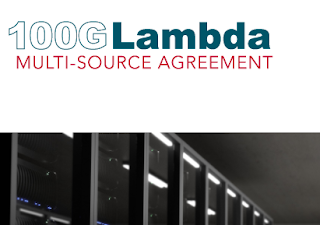The 100G Lambda Multi-Source Agreement (MSA) Group, which was formed just in October 2017, released preliminary specifications based on 100 Gbps per wavelength PAM4 optical technology.
 The new interfaces defined by the 100G Lambda MSA increase the distances supported for 100 GbE and 400 GbE applications compared to the 100 Gbps (100GBASE-DR) and 400 Gbps (400GBASE-DR4) 500-meter reach interfaces currently being defined by IEEE 802.3 Ethernet. The 100G Lambda MSA has developed optical specifications for 100 GbE with reaches of 2 and 10 kilometers and for 400 GbE with a reach of 2 kilometers over duplex single-mode fiber. By focusing on 100 Gbps per wavelength, the 100G Lambda MSA is enabling a technology ecosystem for next-generation networking equipment.
The new interfaces defined by the 100G Lambda MSA increase the distances supported for 100 GbE and 400 GbE applications compared to the 100 Gbps (100GBASE-DR) and 400 Gbps (400GBASE-DR4) 500-meter reach interfaces currently being defined by IEEE 802.3 Ethernet. The 100G Lambda MSA has developed optical specifications for 100 GbE with reaches of 2 and 10 kilometers and for 400 GbE with a reach of 2 kilometers over duplex single-mode fiber. By focusing on 100 Gbps per wavelength, the 100G Lambda MSA is enabling a technology ecosystem for next-generation networking equipment.
Members of the 100G Lambda MSA Group include Alibaba, Applied OptoElectronics, Arista Networks, Broadcom, Ciena, Cisco, Finisar, Foxconn Interconnect Technology, Inphi, Intel, Juniper Networks, Lumentum, Luxtera, MACOM, MaxLinear, Microsoft, Molex, NeoPhotonics, Nokia, Oclaro, Semtech, Source Photonics, and Sumitomo Electric.
The 100G Lambda MSA preliminary specifications are available for download at www.100GLambda.com
 The new interfaces defined by the 100G Lambda MSA increase the distances supported for 100 GbE and 400 GbE applications compared to the 100 Gbps (100GBASE-DR) and 400 Gbps (400GBASE-DR4) 500-meter reach interfaces currently being defined by IEEE 802.3 Ethernet. The 100G Lambda MSA has developed optical specifications for 100 GbE with reaches of 2 and 10 kilometers and for 400 GbE with a reach of 2 kilometers over duplex single-mode fiber. By focusing on 100 Gbps per wavelength, the 100G Lambda MSA is enabling a technology ecosystem for next-generation networking equipment.
The new interfaces defined by the 100G Lambda MSA increase the distances supported for 100 GbE and 400 GbE applications compared to the 100 Gbps (100GBASE-DR) and 400 Gbps (400GBASE-DR4) 500-meter reach interfaces currently being defined by IEEE 802.3 Ethernet. The 100G Lambda MSA has developed optical specifications for 100 GbE with reaches of 2 and 10 kilometers and for 400 GbE with a reach of 2 kilometers over duplex single-mode fiber. By focusing on 100 Gbps per wavelength, the 100G Lambda MSA is enabling a technology ecosystem for next-generation networking equipment.Members of the 100G Lambda MSA Group include Alibaba, Applied OptoElectronics, Arista Networks, Broadcom, Ciena, Cisco, Finisar, Foxconn Interconnect Technology, Inphi, Intel, Juniper Networks, Lumentum, Luxtera, MACOM, MaxLinear, Microsoft, Molex, NeoPhotonics, Nokia, Oclaro, Semtech, Source Photonics, and Sumitomo Electric.
The 100G Lambda MSA preliminary specifications are available for download at www.100GLambda.com




















